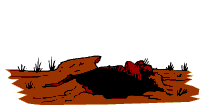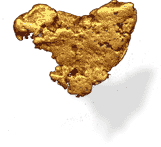


|


Nillinghoo Goldfield
On 25 June it was reported that the contractors, while breaking ore from a shaft at Kerkeeks Treasure, had brought phenomenally rich specimens to the surface. They gave a fully fifty ounces to the ton. With such good prospects, and even better ones expected, the field finally got a twice weekly mail service after FW Sudholz had seen the relevant minister about it. It would arrive on Wednesdays and Saturdays and leave for Adelaide on Thursdays and Sundays. Still not every mine or shaft or alluvial deposit lived up to the high expectations. During this time of glowing reports, the newly formed Nillinghoo Gold Mining Company, incorporated on 17 May, had to ask for a suspension of the working requirements. Having worked for three months with a full complement of men, in the hope of picking up the continuation of Kerkeeks Treasure reef, which is supposed to run through the companys ground somewhere, but thus far have been unsuccessful, the funds of the company are now nearly exhausted. Most people were convinced that some of the properties would eventually become not only dividend paying but also as valuable as the mines in Western Australia. However, in July when a lot of work was done at the mines and by individual prospectors, it was also stated that there should be far less speculation and more work on the ground. Most of the work done at the different mines was carried out by contractors. The contractor for Kerkeeks Treasure was Mr Norton from Stirling North. He had 10 tons of stuff ready to be treated by the government cyanide works at Mount Torrens. During July the goldfield was visited by JV Parkes, W Finlayson, Cockrum and the Hon JH Howe, MP. They inspected claims held by Sudholz and Kerkeek, the Look Out mine, the Look Out Extended and many others. This time they found a nice little town with one of its streets named Parkes Street. However, there were still many tents dotted in all direction. A newspaper reporter was adamant that South Australia had at last discovered a really permanent field. After six months of prospecting and mining, work was carried on in earnest at several of the mines. At the Nillinghoo Gold Mining Companys lease about 600 feet of shafts and drives had been completed whereas at the Eastern Blocks management was calling for tenders to drive a crosscut from the bottom of their main shaft. A crosscut at 70 feet had also been started at Kerkeeks Treasure to prove the width of the lode and at the Western Blocks the no. 2 shaft was down 40 feet. At the Look Out and Look Out Extended they were also busy sinking shafts hoping to cut the reef. The Register found that the Nillinghoo reef bids fair to eclipse anything that has yet been found in that wide auriferous area which lies midway between Petersburg and Broken Hill. According to this paper Kerkeeks Treasure lode has been proved to be the greatest gold-bearing lode that has yet been unearthed in South Australia, and was a prize worth striking for as it was now 21 feet in good payable stone. Kerkeek himself had pegged out an alluvial protection area near his old workings while several other parties were trying for alluvial gold. It was the alluvial miners who were desperate for water as dry blowing was not a very pleasant or successful way of obtaining good results. Prospects obtained during the last few days would likely give more than two ounces to the ton. Early August the Nillinghoo Gold Mining Company had started timbering their no. 3 shaft which was down 36 feet. They planned to go another 100 feet hoping to cut the gold bearing reef, which they expected to be there somewhere. Two weeks later the shaft had reached a depth of 58 feet. Progress had also been made at the Eastern Blocks where a crosscut was started at the 106 level. More good news came from Kerkeeks Treasure where the lode had been proved to be 53 feet wide. While this was in progress contractors were still sinking for a water supply. The mine was visited again by the directors, W Cockrum, FH Bayes and H Gadd. They had a look at several other mines while on the field and expressed great confidence in the permanency of the goldfield. At Lookout Hill, Cockrums shaft was down to the 33 feet level while the Extended was putting in a crosscut at 85 feet. Later that month still more discoveries were made. Two parties had been up before daylight pegging out new claims whereas Nichols, Sullivan and party had struck splendid gold about three kilometres east from the main field. While the lack of water and rain was still a major problem there had been some progress in another matter. For some time the men had been asking for a resident doctor but none had been forthcoming. Their wishes were at last granted, to some extent, when Doctor Shanahan started his practice in Waukaringa and promised to pay a weekly visit to the field. During most of September shafts, drives and crosscuts were extended at several mines. Some through very hard rock and some through soft slaty rocks and needed to be timbered. Unfortunately, samples assayed at the School of Mines in Adelaide proved disappointing. Regardless of these poor results, at Kerkeeks Treasure, the west drive at the 75 feet level was extended to 52 feet and another drive started at the 40 feet level. They reported winning some very rich ore. A few weeks later drives and shafts were extended at Cockrums, Sullivan Claims, the Victor Syndicate and the OReilly mines. JV Parks had an appreciative audience when he gave a lecture on the Extraction of Gold. The best news of all though was that nice general rains had been reported replenishing all the dams in the area. It made the life of diggers a lot easier. As feed was also growing rapidly horses, and other stock, were able to get a full stomach once again. At most of the mines work was in full swing, including the Western Blocks. In November the directors of Kerkeeks Treasure inspected the mine workings and were more than happy seeing the immense orebody in sight. The manager had suspended all work for the time being to concentrate on gaining a water supply before the installation of more machinery. Five tons of high-grade ore had been dispatched to the government cyanide works in the Adelaide Hills, which after treatment returned more than 20 ounces to the ton. This far exceeded what had been anticipated, especially as about eight ounces had already been removed when bagging the ore for transport to Blumberg. When results of the treatment became known in December, general satisfaction was expressed. At a meeting of the Lookout Hill gold mining Company shareholders were told that not a great deal had been done. The original balance sheet showed the sale of 360 shares at 5 each which gave 1800. Purchase of the mine had cost 700 with preliminaries and working expenses amounting to 592.11.3 leaving an amount of only just over 500 to carry on. By the middle of December Kerkeeks Treasure shaft was down to the 141 feet level. At Jophnsons Rush more gold was being discovered and on Lookout Hill another three separate reefs were opened up. Tenders were invited for a crosscut in Cockrums Shaft but none was accepted as they were considered too high. Towards the end of the year a number people at Nillinghoo wanted to sell their businesses or claims but unfortunately for them there were no buyers. Kerkeeks Treasure and the newly formed Western Syndicate had both suspended their works. The Birthday Gold Mining Company was also defunct and the Nillinghoo Gold Mining Company, after spending more than 400 on prospecting, digging, and general fees never even got a speck of gold. Worst still, the Nillinghoo Cricket Club was also defunct, as most players had left the field. This was partly caused by an earlier decision to close all the mines during the Christmas holidays.
*** If you would like to find out more,
|


